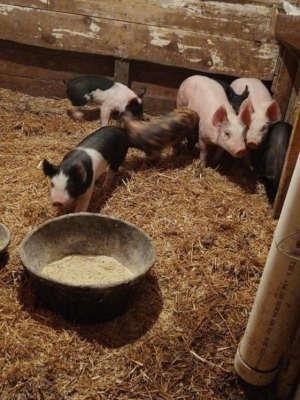By Casey Zangaro
Upcoming MSU Extension online series will describe sound management practices that can help prevent overuse of medication in your swine herd.

Antibiotics have been an important tool for preventing and treating some of the most important diseases in pigs for 70 years. However, in response to One Health and WE CARE initiatives, U.S. pork producers are committed to reducing use of medically important antibiotics to help preserve their effectiveness against diseases that infect both pigs and people. Many diseases in pigs can be prevented or their effects minimized by practicing sound husbandry, biosecurity, and strategic use of vaccines and antibiotics. Advice for implementing these practices is the subject of an online program MSU Extension/Pork plans to release beginning this June.
U.S. swine production has increased over the years to keep pace with the growing global demand for animal protein. Beginning in the early 1950s, farmers began using feed grade antibiotics in livestock to prevent disease and in some cases promote growth and feed efficiency. Use of antibiotics in livestock production increased steadily in the U.S. until 2017 when the Veterinary Feed Directive (VFD) was implemented as a U.S. meat industry response to rising public concern over perceived excessive use of antibiotics in livestock, and its potential impact on antibiotic resistance. VFD bans use of medically important antibiotics (classes used in human medicine) in animal feed and water to promote growth and improve feed efficiency, while allowing their continued use, under closer supervision by veterinarians, to prevent or treat disease.
In the first year following implementation of VFD, sales of feed grade ABs for use in swine production declined by 43%; use of these products specifically for growth and efficiency declined by 94%. However, use of these antibiotics in swine rebounded by 17% in 2018 and 9% in 2019 (last year for which data are available). Based on data reported to the FDA, these increases were under veterinarian supervision and in compliance with VFD guidelines, suggesting their increased use was driven by medical need.
Swine producers understand that use of feed grade antibiotics, though highly effective against some diseases, is not a suitable replacement for sound animal husbandry, biosecurity, appropriate vaccine strategy and judicious use of antibiotics, including injectable. Some of the most important, evidence-based management practices you can implement for your herd are described briefly below. These management practices will be considered in detail through an online program MSU Extension/Pork Working Group is creating this year. This program will include video demonstrations, fact sheets and other materials describing the when, why, and how for each of these practices, including the scientific research underpinning them and expected cost-benefits of each:
- Managing the barn (and pen) environment to minimize disease. This module will describe the importance of maintaining appropriate thermo-neutral conditions, especially in the farrowing facility, and how to best accomplish that. It will also consider strategies for minimizing spread of airborne pathogens, and keeping levels of ammonia, CO2/CO and sulfur-containing gasses within an acceptable range.
- Keeping up with basic biosecurity, by developing and continually reinforcing a sound plan for how visitors/food/equipment are brought onto the farm and into the animal facilities. How rules governing entry into different facilities might differ. The importance of disinfecting everything brought across the line of separation. How just having separate clothing, showering, and daily upkeep on the facility can help pigs thrive.
- Developing and implementing a vaccine strategy with your veterinarian that considers your farm’s history and the disease status of neighboring farms, and cost-benefit of various vaccines available for the diseases you need to prevent.
- Use of non-medically important antibiotics (such as ionophores), zinc, and high value nutritionals (amino acids, pre- and pro-biotics, enzymes) to promote herd health.
- Strategic use of medically important ABs, including best options for minimizing the impacts of scours (which might include in feed or water), and use of injectable whenever possible, including best practices for saving drug and labor when this is done.
- Recordkeeping and maintenance of commonly used equipment will decrease the risk of disease and distressed animals.
- Communication between employees is often overlooked as a key tool. Simply noting why you marked a pig or moved a pig will increase awareness for not only that pig’s health and wellness but the whole herd, too.
Emphasizing an effective management over medication approach in your swine system can benefit your herd’s health while saving money. It can also help maintain a positive eye on your swine operation from the consumer’s perspective. Keep an eye on this space the MSU Extension Pork website for more details around management over medication for your herd.
Source : msu.edu